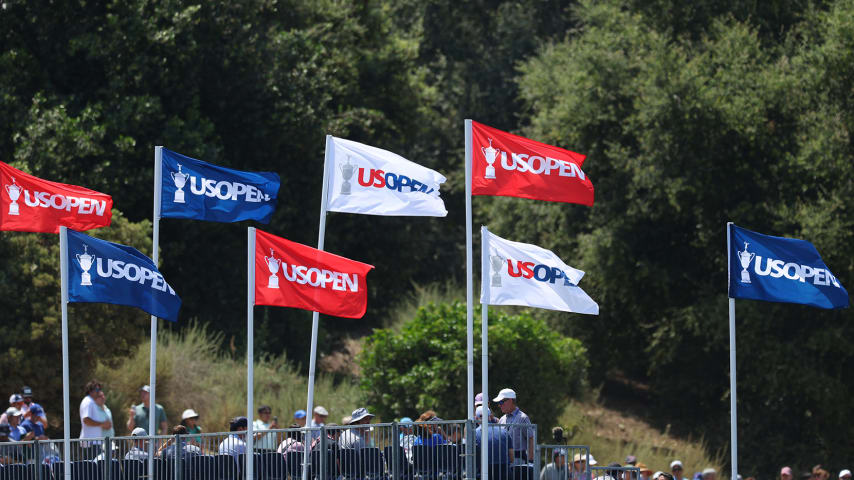Nine things to know: Los Angeles Country Club
12 Min Read

The fifteenth hole at The Los Angeles Country Club (North Course) in Los Angeles, Calif. on Monday, Sept. 26, 2022. (Copyright USGA/J.D. Cuban)
Written by Bradley S. Klein
The 123rd U.S. Open is upon us with all eyes focused on The Los Angeles Country Club’s North Course.
This is the first time the famously private club has hosted the U.S. Open – and the first major professional tournament since a radical renovation of the course by Gil Hanse. In addition to the normal drama of the country’s national championship, there is also the possibility (we hope) of a Michael Block-like figure coming from the ranks of the veritable unknown, whether as an amateur or qualifier. It will be enthralling to watch the world’s best players deal with uneven lies, scratchy-looking bunkers and greens that feed out at the perimeter into totally unpredictable surrounds.
Here are nine things to look for as the week unfolds.
1. PRIME PROPERTY
Los Angeles Country Club sits on more than 300 acres in the midst of West Los Angeles. The land comprising this very private, 36-hole enclave must be among the priciest real estate in golf; or it would be if put out to market. When I asked real estate agents to estimate the value of the property, they laughed before saying “in the billions.” The only comparable golf terrain would be found in London or Tokyo. No worries, it’s not for sale. Having spent upwards of $60 million restoring their two Herbert Fowler/George C. Thomas Jr.-designed golf courses and their sprawling Sumner Hunt-designed clubhouse, the members are thrilled with what they have. The work done here over the last 15 years to upgrade and restore the course has set an entirely new tone for what is possible in the metro-golf market.
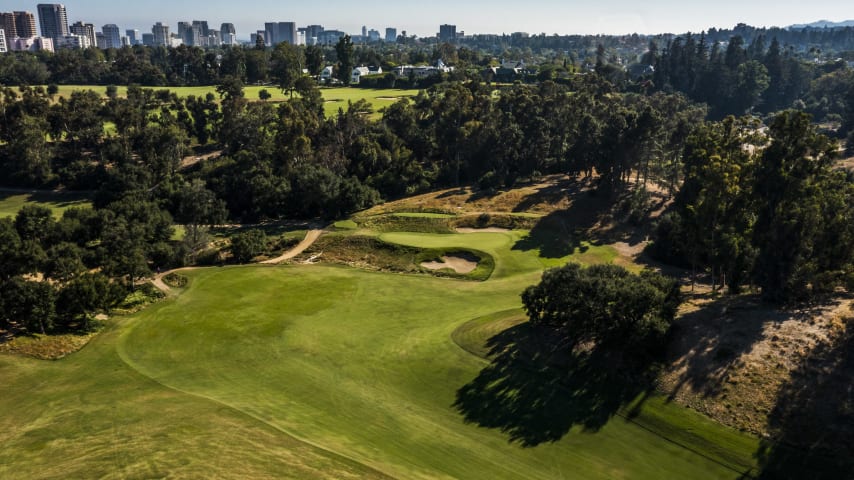
The par-4 sixth hole at The Los Angeles Country Club. (Credit USGA)
2. GOLF CENTRAL
A flyover of Los Angeles might suggest a serious need for green space in the metro area. It’s under-appreciated how much golf courses provide by way of environmental relief. Los Angeles Country Club is part of a vibrant recreational golf culture within a six-mile radius that includes two other Thomas-designed private layouts – The Riviera Country Club and Bel-Air Country Club – as well as Hillcrest Country Club, Brentwood Country Club and a remarkably busy municipal layout, Rancho Park Golf Course.
Given that, it’s hard to believe the USGA waited 75 years before taking the U.S. Open back to the country’s second-largest media market. The first and last time was the 1948 U.S. Open at Riviera, won by Ben Hogan. Maybe it has something to do with traffic and parking – and championship officials are preparing for the possibility of a “Carmageddon” this year with an especially well-planned scheme for buses, autos, and limos. They have also erected a Shinnecock Hills-style bridge to carry pedestrian traffic over Wilshire Blvd. onto club grounds.
Corporate support for the event has been unusually strong, but limited spectator flow due to the barrancas and some condensed routing crossovers have led to a limitation of only 22,000 fans on site – plus about 5,000 service staff, marshals, security, media, etc. Many of those ticket holders are corporate affiliates or associates of members, leaving only 4,500 daily passes available for public access.
3. THE CAPTAIN
Thomas was quite the influential force in golf architecture in the 1920s in Los Angeles and someone we will be hearing about all week. Born in Philadelphia in 1873 to a wealthy family, he devoted his life to golf design, raising dogs and cultivating roses. He was part of the “Philadelphia School” of golf course design that included A.W. Tillinghast, Hugh Wilson and William Flynn. Thomas brought that influence to Southern California in 1919.
Thomas, who was nicknamed “The Captain,” served as Fowler’s construction foreman for Los Angeles Country Club’s two courses before dramatically redesigning the North Course himself in the mid-1920s. Hanse’s renovation was meant to reinvigorate Thomas’ design by bringing back his flowing bunkers and some of his unique green shapes, which had been blunted by the passing years, and re-emphasize the barranca that bisects many holes.
“In golf construction, art and utility meet; both are absolutely vital,” Thomas wrote.
Along the way, Thomas formed a design/construction partnership with William P. Bell that produced such gems as Riviera, Bel-Air CC, Ojai Valley Inn Country Club and Stanford University Golf Course.
Thomas died in 1932 at the age of only 58 but left behind a considerable legacy of about 20 golf courses that bear his stamp as an architect or consultant. He championed variety, diverse ways of playing a golf hole and flexibility in the routing sequence of a course such that players could opt for a short “whiskey run” of holes.
“In considering our ideal or championship course, let us remember the value of diversity and let us include as many varied shots … as possible,” he wrote.
Even for those golf enthusiasts who have never played his courses, his genius as a designer is still palpable thanks to his 1927 book, Golf Architecture in America: Its Strategy and Construction. Long prized by architecture geeks for its insight, to the point where the original hardcover edition was reaping thousands of dollars on the resale market, the text has lately been reissued and is widely available. Between its measured, analytic tone and the quality of its 1920s-era drawings and photos of interesting holes from the classic age of golf design, the book rewards close study and remains fresh upon re-read.
If there were a Golf Architecture Hall of Fame, Thomas would be among its inaugural inductees.
4. HANSE’S WORK
The term “Open doctor” has been retired, thank goodness. Let’s just say that Hanse, the architect behind the North Course’s renovation, has been on quite the roll lately, in no small part due to his recent restoration work on such major sites as Winged Foot Golf Club (2020 U.S. Open), Southern Hills Country Club (2022 PGA Championship), The Country Club of Brookline (2022 U.S. Open), Olympic Club’s Lake Course (2028 PGA Championship), Merion Golf Club (2030 U.S. Open), and Oakland Hills CC (2034 U.S. Open).
He will be a recurring presence throughout the week of the U.S. Open at LACC providing insight on course setup. His long-time associate Jim Wagner consistently provides strong support in the field in terms of planning and implementation but is less prone to media exposure.
The restoration work at LACC involved a protracted period of study, implementation and refinement, beginning in 2008 and continuing up to this year. The major reconstruction work took place in 2009 and 2010. The scope of work involved recapturing the original, expansive greens and the club’s craggy, scraggily bunker look and feel. Extensive tree work opened corridors of play that had been narrowed over the decades. A regressing program provided more uniform stability to the Bermudagrass fairways and more consistency and drought tolerance to the roughs and native areas.
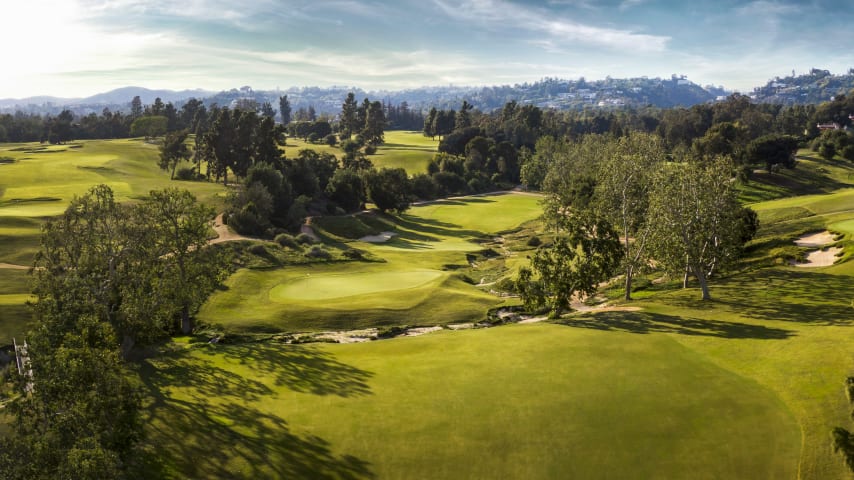
The par-4 second hole at The Los Angeles Country Club. (Credit USGA)
That work overlapped with the tenure of three respected course superintendents, Bruce Williams, Russ Meyer and current head greenkeeper Chris Wilson. A key role was played by local journalist, architecture historian and writer Geoff Shackelford (who also wrote Thomas’ biography).
He provided a detailed narrative of the evolution of the club’s North and South Courses that became essential to their restoration and was on site advising throughout Hanse’s restoration. Another craftsman in the process, Tommy Naccarato, is a legendary if underappreciated, behind-the-scenes activist in golf restoration when it comes to pictorial and image retrieval as well as graphical presentation – duties he attended to during LACC’s restoration.
Along the way, the North Course added length and flexibility. Instead of a uniform width to the fairways, landing areas were flexed according to the lay of the land and sometimes, to link up with adjoining holes – as is done at 1 and 18, 10 and 16, and 13 and 14.
The success of the North Course restoration created momentum for a parallel reworking of the club’s South Course, most of which sits south of Wilshire Blvd., in the shadow of gleaming high-rise office buildings.
5. A WARM WELCOME
The 7,423-yard, par-70 layout as restored by Hanse presents an atypical U.S. Open layout. There are five par 3s and three par 5s – the first such configuration in U.S. Open history and the first time a venue has had five par-3s since the 1947 U.S. Open at St. Louis Country Club. The normal first-tee jitters will be partially mitigated by players knowing that the opening hole, as with Thomas’ nearby opening holes at Riviera and Bel-Air, is an extremely generous par 5, well within reach of two shots by the entire field.
At 578 yards, it tumbles downhill 51 feet from tee to green. The Bermudagrass fairway is the narrowest on the course, only 26 yards wide at the main landing area. Like most of the fairways here, the fairway is wider at the everyday member’s presumed landing zone but gets thinner in the area where the pros hit it.
A trio of bunkers intrudes partially on the line of play, 265 yards to carry on the right but 305 yards on the left and thus more in play. Players going for the green only need to carry a bunker on the right, 70 yards short of the green and let gravity take over. The entrance to this fall-away putting surface is open, except for a yawning greenside bunker on the left which will be a factor when the hole is cut in the back left. The first hole will play well under par for the week and provide momentary relief before the turmoil that follows.
6. A COURSE WITHIN A COURSE
Thomas liked to tout what he called the “a course within a course”: everything from shortened loops of four- or seven-hole jaunts, to an extra hole or an alternative way of playing a hole thanks to different teeing grounds and myriad hole locations that could dramatically alter the preferred line of attack.
The North Course has it all, including an extra 17th hole – a remnant par-3 from an earlier routing that was left like an appendage – visible from the back of the main 17th green.
USGA officials intend to honor Thomas’ design intent, for example on the par-4 fifth hole, 480 yards on the scorecard, but likely to be shortened considerably in conjunction with the deployment of an obscure, far right, front hole location tucked just beyond two steep greenside bunkers.
7. DRIVABLE BUT NOT EASY
Beware of so-called “breather holes.” As evident at the 10th hole at Riviera, Thomas was a master of the intriguing short-par 4. At LACC, the spotlight will be on the 330-yard, par-4 sixth hole. It’s downhill 54 feet from tee to green, only 292 yards in the air to the front of the putting surface. But it’s the smallest, narrowest green on the course. Reaching it is not the problem; holding it is the key.
“The skill required on holes of shorter length should be as great as on long holes,” Thomas wrote.
There is a crater-like bunker front left that will do a lot of business during the U.S. Open. During practice rounds, players will be trying anything here, including a lay-up to an elusive fairway that is best described as a reverse camber chicane – canted right to left against the grain of a hole turning left to right. When the pin is set in the back it makes sense actually to drive past the green into the far left corner of the fairway and then turn around and pitch back to the flag. It might be confusing to read about but it will be entertaining to watch.
8. THOSE BACK-NINE PAR 3s
The modern trend toward diversity and “half par” holes is on display here on the back nine, with the 11th hole playing 290 yards and the 15th a mere 124. It gets even better, since at least one round, that little 15th hole will be set up to play in double digits – only 92 yards – the shortest in modern U.S. Open history.
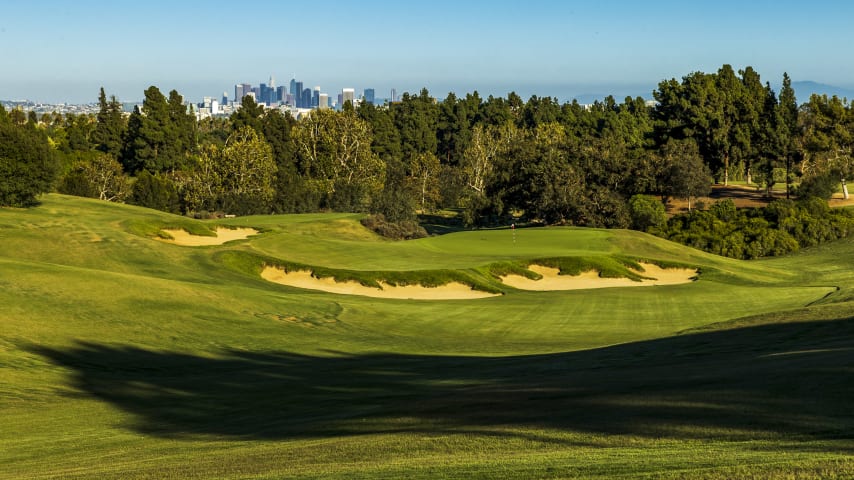
The 11th hole of The Los Angeles Country Club, North Course. (Credit USGA)
Meanwhile, the long 11th hole will steal the show visually thanks to a gorgeous backdrop of downtown Los Angeles looming way behind the green. You can thank considerable tree work for that view. The 11th is technically a reverse Redan – the Rorschach double to a classic template hole, the 15th at North Berwick, Scotland.
The LACC version plays from on high, 57 feet above the green, to a landing area sloped left-to-right with the master bunkering sitting low on the right side of the landing area and green. Rare is the par 3 where elite players will try to land the ball short of the green and let it run up. That’s the smart play here, particularly because the green falls ever so gently away from the line of approach, making the judgment of the proper landing point a matter of considerable skill.
9. OH, THAT FINISH
The little par-3 15th comes as a rest stop along the way of a very long highway. Appropriately enough, the 43-yard-long green assumes the shape of a teardrop. With the narrowest part up front, it can play as short as 72 yards, which it did for one session of matches at the 2017 Walker Cup. For the U.S. Open, we can expect it to play as short as 92 yards and as long as 155.
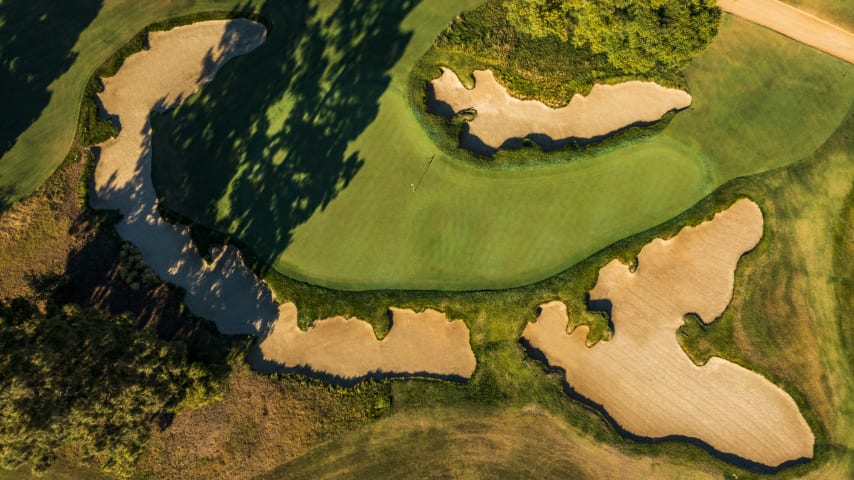
How is this for a change of pace? That tiny par-3 follows a par-5 14th measuring 623 yards and comes before a trio of par 4s clocking in at 543, 520 and 493 yards. That collection of concluding par 4s averages 518.7 yards, an unthinkable distance a few decades ago but now standard operating procedure to test elite players.
It also fits in with Thomas’ idea that “the last three holes should be of exceptional character, and the last hole, undoubtedly, should be a fine (par-4).”
The 16th and 17th holes play downhill with the 18th very much back upland, 40 feet from tee to the green and extremely demanding off the tee. You can thank the steady dogleg left for that; the main issue is not a yawning fairway bunker inside the fairway turn (easily carried, at 223 yards to fly), but the dense Bermudagrass rough and the way the fairway, only 28 yards wide, subtly cants to the right.
The hole, in returning to the clubhouse just behind, parallels the generous opening hole on its left and provides an elegant conclusion to a fascinating set of golf holes.
| Los Angeles Country Club - North Course | ||
| Hole | Par | Yardage |
| 1 | 5 | 578 |
| 2 | 4 | 491 |
| 3 | 4 | 419 |
| 4 | 3 | 228 |
| 5 | 4 | 480 |
| 6 | 4 | 330 |
| 7 | 3 | 284 |
| 8 | 5 | 547 |
| 9 | 3 | 171 |
| 35 | 534 | |
| 10 | 4 | 409 |
| 11 | 3 | 290 |
| 12 | 4 | 380 |
| 13 | 4 | 507 |
| 14 | 5 | 623 |
| 15 | 3 | 124 |
| 16 | 4 | 543 |
| 17 | 4 | 520 |
| 18 | 4 | 493 |
| 35 | 3,887 | |
| 70 | 7,423 | |











